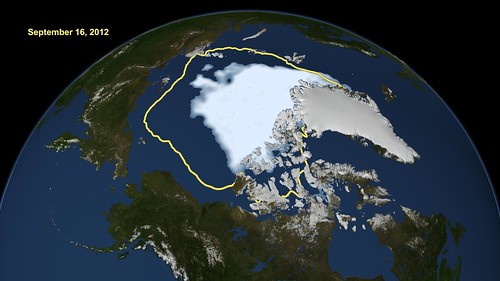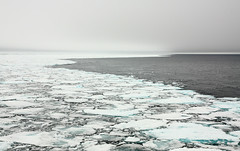美國國家冰雪資料中心(NSIDC)的科學家表示,目前北極海冰的夏季覆蓋面積,已降至1979年開始利用衛星記錄以來的最低覆蓋率。該最新數據暗示北半球可能會面臨嚴酷的冬季氣候,也促使保育人士整合國際行動來面對極地危機。
「我們現在來到未知疆域。雖然我們早就知道當地球逐漸暖化,北極是最早被影響、也是影響最明顯的地區,不過我們大部份人對於實際發生的迅速變化,並沒有心理準備。」NSIDC執行長賽瑞茲(Mark Serreze)如此表示。

2012年9月16日的衛星資料,顯示北極海冰範圍的新低紀錄,黃色線區域是過去30年最低記錄的平均。
圖片由美國航太總署(NASA)哥達德科學顯影動畫(Goddard Scientific Visualization Studio)提供。
9月16日,北極海冰面積降至341萬平方公里,這是有衛星記錄以來,夏季的最低覆蓋面積(可參考NASA哥達德太空飛行中心提供的動畫:http://www.flickr.com/photos/gsfc/8003901788/)。
NSIDC科學家指出,這只是初步數據,變化中的氣候條件可能會讓海冰面積下降。目前北極海冰融化的速度,比過去氣候模型預測的還要快。
賽瑞茲說,「很多人在談論『西北通道』的開通,也就是穿越加拿大的北極島嶼和沿著俄羅斯海岸的北海通道,20年後的8月天裡,我們可能可以搭船直接穿越北極海。」
北極海冰在冬季進入數個月永夜期時會結冰,在夏季永晝期會融化縮小。每年北極海冰在9月會達到最小面積。
今年夏季北極的海冰面積突破最低紀錄,比1979年~2000年最小面積的平均,還少了一半。NSIDC科學家麥爾(Walt Meier)說,「海冰面積在夏季尾聲大幅縮小,顯示海冰層有多薄。當秋季到來進入永夜期,海冰一定是非常薄才會持續融化。」
根據NSIDC科學家觀察,北極通常會有多層海冰,或者是長久不融化的海冰。但是近來北極隨季節變化的海冰增加,而且夏季時大範圍的海冰已經注定會完全融化。
危機來臨 還有人想著去鑽油
9月19日,綠色和平組織的執行長奈多(Kumi Naidoo)和國際環保組織「350.org」創辦人麥奇本(Bill McKibben)與NASA氣候學家韓森(James Hansen),在美國紐約斯堪地那維亞餐廳舉辦的綠色和平論壇討論極地的緊急狀況,希望號召並協調國際對於極地危機的回應。
奈多表示 ,「我們今天的號召是人類歷史上的決定性時刻,不過30多年時間,我們已經改變地球從外太空看起來的模樣,而且不久後夏季時的北極海冰可能會完全融化。」「目前各國領袖的反應是觀望北極海冰的融化,等著後續分配戰利品,而不是處理氣候變遷的根本原因。」
,「我們今天的號召是人類歷史上的決定性時刻,不過30多年時間,我們已經改變地球從外太空看起來的模樣,而且不久後夏季時的北極海冰可能會完全融化。」「目前各國領袖的反應是觀望北極海冰的融化,等著後續分配戰利品,而不是處理氣候變遷的根本原因。」
麥奇本也指出,「北極真是地球上最反諷的地方。我們的反應不是提出警告、驚恐或急迫感,反而是『一起去挖石油吧!』這真是我們無能解決最嚴重問題時,最為諷刺的控訴。」
綠色和平組織正急於在北極無人居住的地區創造避難所,並且取締在北極進行有違永續經營的企業活動。
自從2012年6月,已經有超過180萬人加入綠色和平組織「拯救北極」的活動(savethearctic.org),該團體計畫明年在北極海床鋪上「北極名冊」,寫下破壞極地的企業名稱,以抗議這些商業利益的行為。
NSIDC科學家史多福(Julienne Stroeve)目前正與綠色和平組織共同航行在挪威斯瓦巴群島附近的北極海域,研究該區域破紀錄的海冰融化狀況。
史多福說,「新的紀錄顯示北極正進入一個全新的氣候時代,更薄的海冰以及更溫暖的空氣與海溫,導致夏季海冰更加縮小。這將會導致北極大氣異常的溫暖,接著影響北半球的氣候模式,最終可能造成持續的極端氣候,例如乾旱、熱浪和洪水。」
美國首都暴雪 疑骨牌效應導致
今年6月美國康乃爾大學在《海洋學》發表研究,詳加解釋氣候變遷導致北極海冰融化可能會引發骨牌效應,提高北半球中緯度嚴酷冬季氣候發生的機率。我們回想2010年2月,癱瘓美國華盛頓特區的「末日暴雪」(Snowmageddon)就可以理解了。
康乃爾大學的地球與大氣科學家格林恩(Charles Greene)說,「每個人都認為北極氣候改變是遙遠的現象,對我們的日常生活沒有太大影響。但是發生在遙遠北極的事件,是我們這裡氣候改變的壓力。」
北極震盪讓冷空氣外擴
最新的極地觀察,是「北極震盪」(Arctic Oscillation,AO)的一個新的變形。北極震盪是北半球氣候模式的一種自然變異,在人類造成地球暖化以前,北極氣候系統自然地在偏好或不利冷空氣外擴的狀況下震盪。
格林恩表示,「現在我們面對的是氣候系統的改變,特別是在北極,AO狀態傾向讓冷空氣向外擴散,造成嚴酷的冬季氣候,這可能就是我們這幾年所面臨的。」
上一個冬季,擴張的冷空氣在2012年1月中旬降到中歐和東歐,不但氣溫降到-30℃,雪甚至積到屋頂高度。
過去兩年,美國東部城市都有暴風雪的紀錄,包括華盛頓、紐約、費城,以及很多其他東部的沿海地帶。
歐洲和美國阿拉斯加在冬季都經歷破紀錄的暴風雪,而全球在2012年的3月平均溫度,是1999年以來最低的。
格林恩說,「很多時候人們都說:『且慢,那以後是會更冷還是更熱?』嗯,這有賴於許多因素,我猜我們經歷的上一個冬季就是最好的例子,我們可以預期,未來北極將傾向帶來更嚴酷的冬季氣候。」
Arctic sea ice cover is now at the lowest summer minimum extent since satellite records began in 1979, say scientists at the National Snow and Ice Data Center, NSIDC. The new data prompted forecasts of severe winter weather across the Northern Hemisphere and a call from conservationists for a coordinated international response to the polar crisis.
“We are now in uncharted territory,” said NSIDC Director Mark Serreze. “While we’ve long known that as the planet warms up, changes would be seen first and be most pronounced in the Arctic, few of us were prepared for how rapidly the changes would actually occur.”
On September 16, Arctic sea ice cover fell to the lowest summer minimum extent in the satellite record – 1.32 million square miles (3.41 million square kilometers), as shown in this animation from the NASA Goddard Space Flight Center.
This number is preliminary, and changing weather conditions could push the ice extent still lower, NSIDC scientists say. The Arctic sea ice is melting much more quickly than climate models had predicted.
Serreze said, “While lots of people talk about opening of the Northwest Passage through the Canadian Arctic islands and the Northern Sea Route along the Russian coast, 20 years from now from now in August you might be able to take a ship right across the Arctic Ocean.”
Arctic sea ice cover grows each winter as the Sun sets for several months, and shrinks each summer as the Sun rises higher in the northern sky. Each year, the Arctic sea ice reaches its minimum extent in September.
This year’s minimum follows a record-breaking summer of low sea ice extents in the Arctic. This year’s minimum will be nearly 50 percent lower than the 1979 to 2000 average.
“The strong late season decline is indicative of how thin the ice cover is,” said NSIDC scientist Walt Meier. “Ice has to be quite thin to continue melting away as the Sun goes down and fall approaches.”
NSIDC scientists say the Arctic used to be dominated by multiyear ice, or ice that survived through several years. Lately, the Arctic is increasingly characterized by seasonal ice cover and large areas are now prone to completely melt away in summer.
Today Greenpeace International Executive Director Kumi Naidoo, joined 350.org founder Bill McKibben and NASA climate scientist Dr. James Hansen at a Greenpeace panel discussion on the polar emergency at Scandinavia House in New York, to call for a coordinated international response to the polar crisis.
“Today’s announcement represents a defining moment in human history,” said Naidoo. “In just over 30 years we have altered the way our planet looks from space, and soon the North Pole may be completely ice free in summer.”
“Rather than dealing with the root causes of climate change the current response from our leaders is to watch the ice melt and then divide up the spoils,” said Naidoo.
McKibben said, “There’s no place on Earth where we see the essential irony of our moment playing out more perfectly than in the Arctic. Our response has not been alarm, or panic, or a sense of emergency. It has been: ‘Let’s go up there and drill for oil.’ There is no more perfect indictment of our failure to get to grips with the greatest problem we’ve ever faced.”
Greenpeace is urging the creation of a sanctuary in the uninhabited area around the North Pole and a ban on unsustainable industrial activity in the rest of the Arctic.
Since June 2012 more than 1.8 million people have joined Greenpeace’s Save the Arctic campaign (savethearctic.org), and the group intends to place an “Arctic Scroll” carrying these names on the seabed beneath the North Pole early next year as an act of opposition to corporate interest in the region.
Dr. Julienne Stroeve, a scientist with the NSIDC, is currently aboard a Greenpeace ship in the Arctic region of Svalbard, Norway, after researching the region’s record breaking ice melt.
“This new record suggests the Arctic may have entered a new climate era, where a combination of thinner ice together with warmer air and ocean temperatures result in more ice loss each summer,” said Stroeve. “The loss of summer sea ice has led to unusual warming of the Arctic atmosphere, that in turn impacts weather patterns in the Northern Hemisphere, that can result in persistent extreme weather such as droughts, heat waves and flooding.”
A Cornell University study published in the journal “Oceanography” in June explains more about how the melt-off of Arctic sea ice due to climate change can trigger a domino effect leading to increased odds of severe winter weather outbreaks in the Northern Hemisphere’s middle latitudes – think the “Snowmageddon” storm that paralyzed Washington, DC in February 2010.
Cornell’s Charles Greene, professor of earth and atmospheric sciences, said, “Everyone thinks of Arctic climate change as this remote phenomenon that has little effect on our everyday lives. But what goes on in the Arctic remotely forces our weather patterns here.”
The recent observations present a new twist to the Arctic Oscillation, or AO, a natural pattern of climate variability in the Northern Hemisphere. Before humans began warming the planet, the Arctic’s climate system naturally oscillated between conditions favorable and those unfavorable for invasions of cold Arctic air.
“What’s happening now is that we are changing the climate system, especially in the Arctic, and that’s increasing the odds for the negative AO conditions that favor cold air invasions and severe winter weather outbreaks,” Greene said. “It’s something to think about given our recent history.”
This past winter, an extended cold snap descended on central and Eastern Europe in mid-January, with temperatures approaching minus 22 degrees Fahrenheit and snowdrifts reaching rooftops.
There were record snowstorms in eastern U.S. cities, such as Washington, New York and Philadelphia, as well as many other parts of the Eastern Seaboard during the previous two years.
Europe and Alaska experienced record-breaking winter storms, and the global average temperature during March 2012 was cooler than any other March since 1999.
“A lot of times people say, ‘Wait a second, which is it going to be – more snow or more warming?’ Well, it depends on a lot of factors, and I guess this was a really good winter demonstrating that,” Greene said. “What we can expect, however, is the Arctic wildcard stacking the deck in favor of more severe winter outbreaks in the future.”
※ 全文及圖片詳見:ENS







